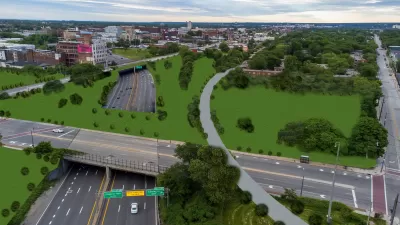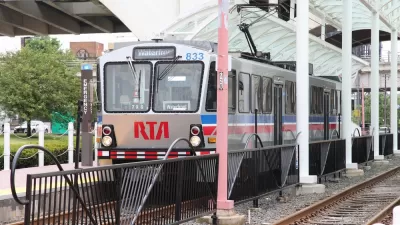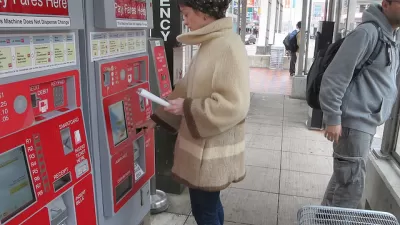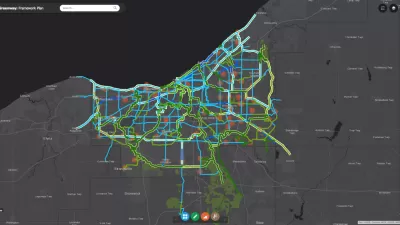A proposal to cap part of the Innerbelt Freeway east of Downtown Cleveland would require the demolition of a vacant, historic courthouse near the East 22nd Street Bridge.

Steven Litt reports for Cleveland.com on an ambitious proposal for the demolition of the Cuyahoga County Juvenile Court Building, a vacant county landmark built in 1931, to create space for a freeway cap project called “Reconnect Cleveland.” The Campus District Inc. is proposing the demolition and cap project in response to a request for proposals (RFP) from Cuyahoga County for the redevelopment of the historic courthouse
“The nonprofit wants to see the old courthouse demolished in order to make room for a green, aesthetically pleasing deck, or ‘cap,’ over the Innerbelt freeway trench next to the East 22nd Street Bridge, plus new development that could occur on part of the land where the courthouse now stands,” writes Litt.
“The cap would be big enough to carry a future regional bike path that would link Slavic Village to downtown, the lakefront, the Towpath Trail, and the Cuyahoga Valley,” explains Litt of the benefits touted in the Campus District’s documents presented in response to the RFP.
The Campus District is a community development corporation covering a swath of neighborhoods east of downtown Cleveland, including Cleveland State University, the Metro Campus of Cuyahoga Community College, and St. Vincent Charity Hospital.
According to Litt, the proposal already has strong support from political leadership and local organizations. The proposal has special urgency as the Ohio Department of Transportation plans the next stage of the Innerbelt Modernization Plan, which Litt describes as a “multi-decade project to revamp the Innerbelt, the eight-mile collection of freeway lanes converging on the west, south and east sides of downtown to link interstates 71, 77, and 90.”
FULL STORY: Nonprofit Campus District proposes removing old Juvenile Court to cap Innerbelt with green park

Planetizen Federal Action Tracker
A weekly monitor of how Trump’s orders and actions are impacting planners and planning in America.

Maui's Vacation Rental Debate Turns Ugly
Verbal attacks, misinformation campaigns and fistfights plague a high-stakes debate to convert thousands of vacation rentals into long-term housing.

San Francisco Suspends Traffic Calming Amidst Record Deaths
Citing “a challenging fiscal landscape,” the city will cease the program on the heels of 42 traffic deaths, including 24 pedestrians.

Amtrak Rolls Out New Orleans to Alabama “Mardi Gras” Train
The new service will operate morning and evening departures between Mobile and New Orleans.

The Subversive Car-Free Guide to Trump's Great American Road Trip
Car-free ways to access Chicagoland’s best tourist attractions.

San Antonio and Austin are Fusing Into one Massive Megaregion
The region spanning the two central Texas cities is growing fast, posing challenges for local infrastructure and water supplies.
Urban Design for Planners 1: Software Tools
This six-course series explores essential urban design concepts using open source software and equips planners with the tools they need to participate fully in the urban design process.
Planning for Universal Design
Learn the tools for implementing Universal Design in planning regulations.
Heyer Gruel & Associates PA
JM Goldson LLC
Custer County Colorado
City of Camden Redevelopment Agency
City of Astoria
Transportation Research & Education Center (TREC) at Portland State University
Jefferson Parish Government
Camden Redevelopment Agency
City of Claremont





























